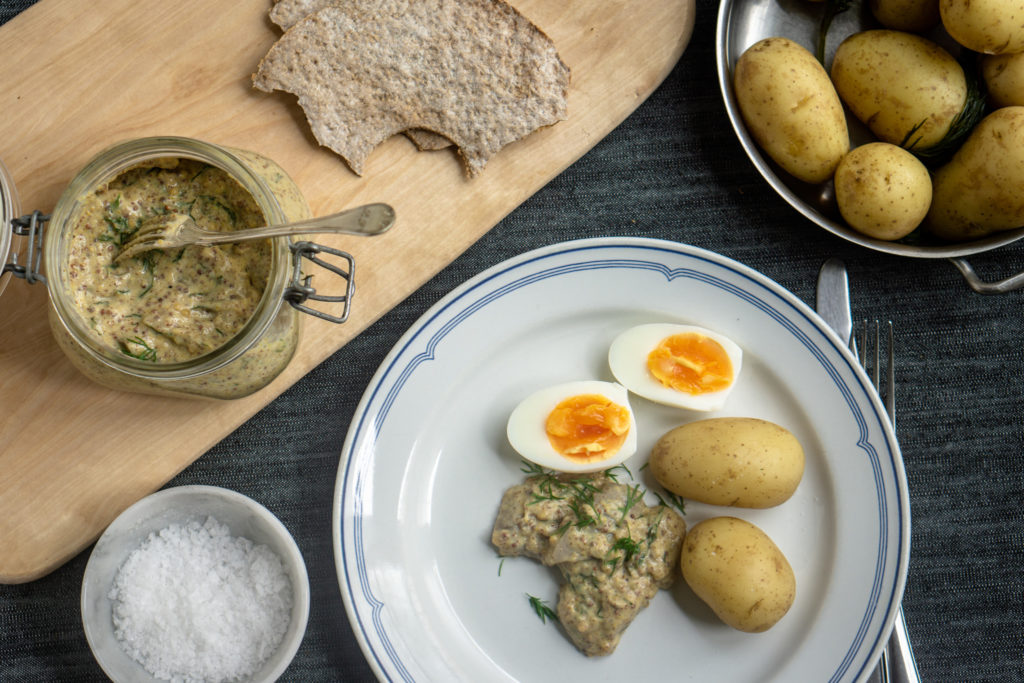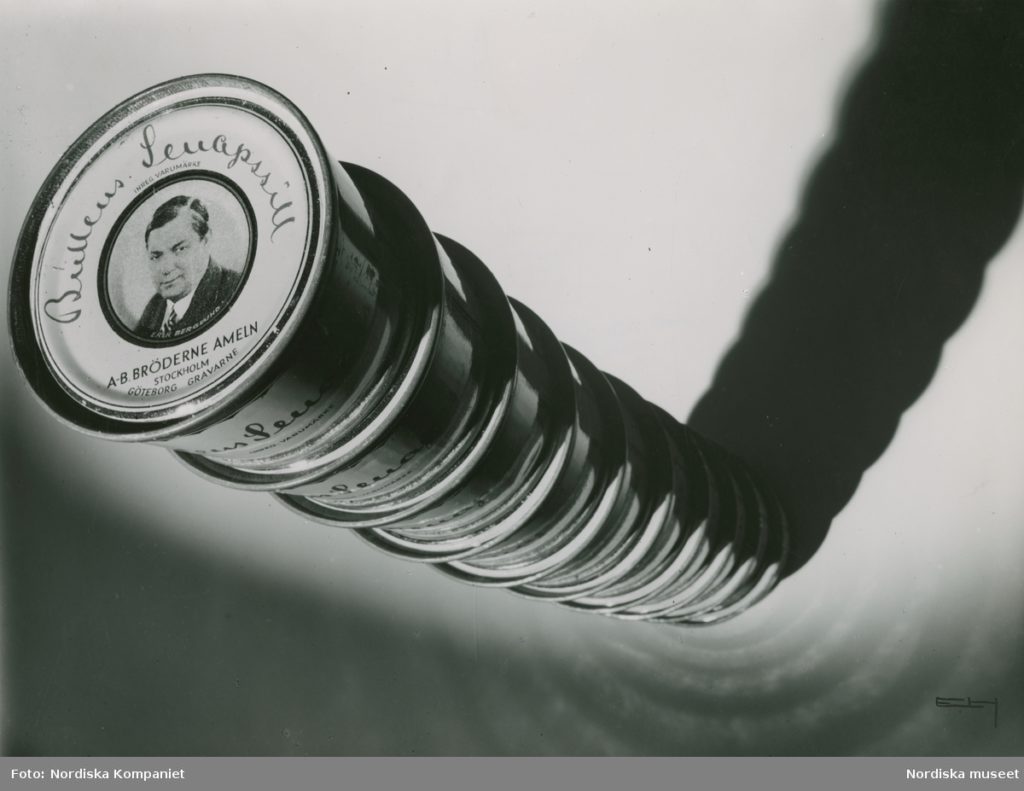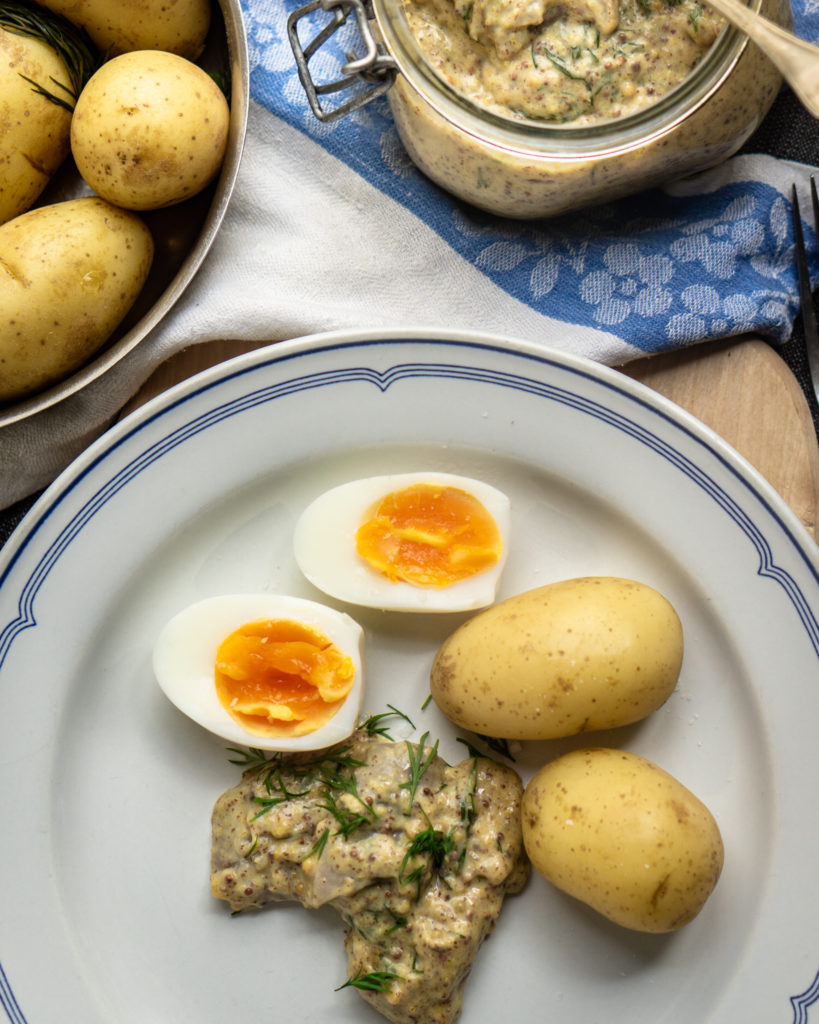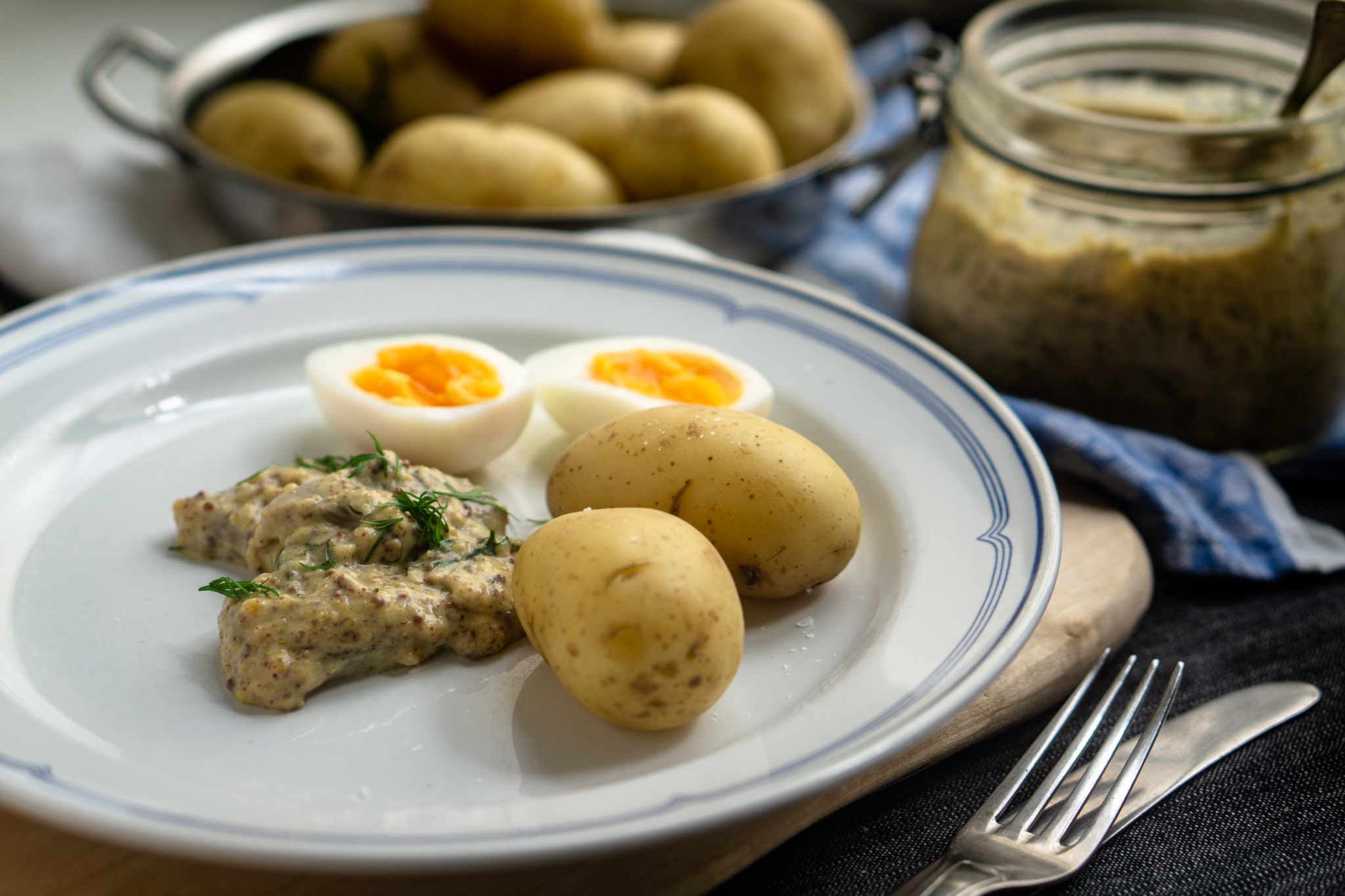Have you ever had this food experience? For years, you’ve enjoyed eating something from the stores. Then, one day, you taste the homemade version and realize — there’s no going back. This is it. What on earth were you really eating before? This is the real thing, this is what it’s supposed to taste like! When it comes to herring in mustard sauce, I divide my herring-eating into before and after tasting Järvsöbaden’s version.
Yes, it is THAT good.
Järvsöbaden is a magical boarding house and hotel in Järvsö in Hälsingland. It was founded in 1905, although they apparently had an inn there already in the 16th century. And let me tell you, this place takes craftsmanship seriously when it comes to food. All lunches and dinners are served buffet-style, starting with a generous smörgåsbord of herring, cheese, and salad. (No, I’m not sponsored, but I have loved this place since I was a child.)
A few years ago, I casually speared a few pieces of mustard herring from their buffet and went back to my seat to enjoy my starter. The sensation! The flavor! A strong but well-balanced kick of mustard, a hint of sweetness, a lusciously creamy sauce…
That’s when I realize how incredibly sweet-tasting the store-bought herring in mustard sauce is. And, the taste of mustard? It only lingers in the background. Actually, I’d go as far as to say that most people unknowingly like this type of mustard because of its sugar contents…
By now, you’ve probably declared me a mustard herring snob, but I do devour a few of the Abba jars of herring in mustard sauce from time to time. But for special occasions? Home-made is the way to go. Luckily, it’s not difficult at all.
Click here to get straight to the recipe for herring in mustard sauce.
Herring in mustard sauce — a Swedish classic?
We’ve already looked at the history of herring in Sweden in the article about plain pickled herring. So, let us here instead take a look at the mustard-covered version.
Anna-Maria Zetterstrand‘s cookbook from 1863 features a recipe for fresh herring boiled in vinegar, which is served with a sauce of butter, flour, vinegar, mustard, yolks, and cream (p 161). From the rest of her herring recipes, it is clear that herring was a common dish on smörgåsbord.
In 1896, Charles Emil Hagdahl’s cookbook has two herring recipes (p 282) that feature a mustard sauce on the side. One sauce recipe is close to Zetterstrand’s above, and the other features only butter and mustard.
Still, no the herring in mustard sauce isn’t pickled — Zetterstrand’s is boiled and Hagdahl’s are boiled or grilled. And in Iduns hjälpreda from 1899 (p 91), the herring may be pickled, but the mustard is only added to the pickling-brine, not as a separate sauce.

Herring dishes galore!
Let’s take a look at a few 20th-century sources. Kerstin Wenström’s Husmoderns kokbok from 1927 features a recipe for cured Baltic herring, which has a sauce made of oil, vinegar, and French mustard (p 70) — a lot of contemporary mustard sauce recipes look similar.
But, when we get to Prinsessornas kokbok from 1934, something new is happening. The old cookbooks (18-19th century) often featured a few dishes with boiled, fried, and pickled herring — not to mention fiskbollar, “fish balls”. This cookbook features a long line of herring dishes — “delicacy herring” in tomato sauce, herring in cream sauce, filled herring (pp 11). At least one of them features mustard, but not as the main flavor. The book does however feature a mustard sauce (p 221), recommended for cod or haddock.
Why all these new dishes? Well, the name of the section in the cookbook, called Smörgås-, lunch-, och mellanrätter — dishes for lunch, snacks, and pre-courses — gives us a clue. The Swedish way of entertaining was evolving. According to food historian Jan-Öjvind Swahn’s Mathistorisk uppslagsbok (p 274), the old “schnapps table” (brännvinsbordet) had evolved during the late 19th century into the type of smörgåsbord we see today. Until the Second World War, dinners would start with a smörgåsbord. Even a lone diner at a restaurant would expect to get several small dishes.

When does herring in mustard sauce take off?
It seems likely that the dish was developed in the first half of the 20th century, in the 30s or earlier, during the smörgåsbord craze. As early as in 1902, J. F. Broms and Son offers herring in mustard sauce in Svenska Dagbladet. However, it really takes off in 1932, when Svenska Dagbladet starts to run ads for Bullens senapssill. Maybe Bullen launched mustard herring in jars this year. The 18th of June ad suggests that “everyone should have a jar of Bullens mustard herring on the smörgåsbord in Midsummer”, claiming that it is a popular novelty. Other ads tout the mustard herring as the delicacy of the smörgåsbord.
Svenska Dagbladet also features recipes of mustard herring. One of the earliest ones from 1937 flavors the pickling brine with mustard and dill. This sauce sounds delicious but isn’t the creamy version we’re used to today.
Herring in mustard sauce — the contemporary recipes
Let’s start with the grand old man of Swedish cooking, Tore Wretman. In Svensk Husmanskost (s 30), his mustard sauce features vinegar, oil, thick cream, two types of mustard, white pepper, and dill. Simple as that. And it sounds delicious.
Leif Mannerström’s similar recipe in Husmanskonst (p 101) requires far more ingredients — he uses vinegar, oil, cream, crème fraîche, sugar, two types of mustard, mayonnaise, onion, dill, chives, salt, and white pepper. Hopefully, you’d have at least a few of the ingredients at home, though. The crème fraîche makes up the bulk of the creamy ingredients, but he uses just as much oil.
Magnus Nilsson features two recipes of herring in mustard sauce in The Nordic Cookbook (p 206) — one with fresh and one with pickled herring. Interestingly, the sauce he uses for pickled herring is hovmästarsås, a sweet mustard sauce that normally is served with gravlax. Others, like Det nya svenska köket (p 42), use a similar approach. Instead, Nilsson quick-pickles the fresh herring and then mixes it with a mustard sauce with vinegar, mustard, oil, and cream, and seasoned with salt, pepper, and dill.

How to make delicious herring in mustard sauce
There’s only one rule here — make it according to your taste. This recipe has a stronger mustard flavor than the store-bought version. If you’re not so fond of that, then take it down a notch. Add a little of the mustard at a time, and adjust with lemon or vinegar for acidity and sugar or honey to get a well-balanced flavor. Also, it’s fine if you only have one type of mustard at home. I use three because I like the complexity of the flavors.
The big difference between my recipe and the celebrated chefs (oh, the cockiness) is that there’s no oil. It may add to the consistency but I have never missed it — and skipping it makes the dish considerably lighter. Meaning, you can eat more without any bad conscience…
For one good jar of herring — serves four people as a starter or light lunch:
Ingredients
400 gr (slightly less than a pound) pickled herring
2 tbsp Dijon mustard
2-3 tbsp mustard (I tend to use a sweet-and-strong mustard called Gravilejs)
2-3 tbsp grainy mustard (optional: you can skip this, or use more normal mustard instead)
1 1/2 dl (3/5 cups) crème fraîche
white pepper
2-3 tbsp chopped dill
sugar or honey, to taste (optional)
white wine vinegar or lemon juice, to taste (optional)
Method
- Prepare the pickled herring by cutting it in pieces, if it isn’t in pieces already. Drain the herring.
- In a bowl, mix the mustards and crème fraîche or soured cream until it is well blended. Add a pinch of white pepper and the dill and stir.
- Taste test. Depending on your preferences and how sweet your mustard is, you may want to add some sugar or honey (if you want something closer to the Abba brand version, definitely add sugar). Alternatively, maybe a few drops of vinegar or lemon juice is needed to freshen it up. The sauce will be slightly diluted by the herring, but add more crème fraîche if the mustard flavor is too overpowering.
- Add the pickled herring and stir. You can serve this dish straight away as the herring already is pickled, but it becomes even tastier if you let it rest in the fridge for at least six hours or preferably overnight. Store in the fridge.
Suggestions
Mustard herring is of course splendid on any smörgåsbord. You can also serve the herring with boiled potatoes, a boiled egg, and some crispbread for a light lunch. Or, put it on a piece of crispbread for a quick snack.
I use crème fraîche instead of cream because I enjoy the slightly acidic taste and the effect it has on the consistency. Unwhipped cream is too runny, and whipped cream will sometimes not hold well. You can use the same amount of soured cream or a mix of mayonnaise and thick yogurt if you prefer.
Make your own pickled herring (you can leave out the leek, onion, and carrots in this recipe) or buy a plain type of pickled herring in the stores.



Thanks for great info and history!
Good to know you appreciated it, Harrison!
This is EXCELLENT thank you! Very simple and very delicious.
Thank you for your comment, Martha, I appreciate it!